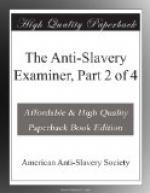On the 9th of January, 1829, the House of Representatives passed the following resolution by a vote of 114 to 66: “Resolved, That the Committee on the District of Columbia, be instructed to inquire into the expediency of providing by law for the gradual abolition of slavery within the District, in such a manner that the interests of no individual shall be injured thereby.” Among those who voted in the affirmative were Messrs. Barney of Md., Armstrong of Va., A.H. Shepperd of N.C., Blair of Tenn., Chilton and Lyon of Ky., Johns of Del., and others from slave states.
2. IT HAS BEEN CONCEDED BY COMMITTEES OF CONGRESS, ON THE DISTRICT OF COLUMBIA.—In a report of the committee on the District, Jan. 11, 1837, by their chairman, Mr. Powell of Va., there is the following declaration: “The Congress of the United States, has by the constitution exclusive jurisdiction over the District, and has power upon this subject (slavery,) as upon all other subjects of legislation, to exercise unlimited discretion.” Reports of Comms. 2d Sess. 19th Cong. v. iv. No. 43. In December, 1831, the committee on the District, Mr. Doddridge of Va., Chairman, reported, “That until the adjoining states act on the subject, (slavery) it would be (not unconstitutional but) unwise and impolitic, if not unjust, for Congress to interfere.” In April, 1836, a special committee on abolition memorials reported the following resolutions by their Chairman, Mr. Pinckney of South Carolina: “Resolved, That Congress possesses no constitutional authority to interfere in any way with the institution of slavery in any of the states of this confederacy.”
“Resolved, That Congress ought not to interfere in any way with slavery in the District of Columbia.” “Ought not to interfere,” carefully avoiding the phraseology of the first resolution, and thus in effect conceding the constitutional power. In a widely circulated “Address to the electors of the Charleston District,” Mr. Pinkney is thus denounced by his own constituents: “He has proposed a resolution which is received by the plain common sense of the whole country as a concession that Congress has authority to abolish slavery in the District of Columbia.”
3. IT HAS BEEN CONCEDED BY THE CITIZENS OF THE DISTRICT. A petition for the gradual abolition of slavery in the District, signed by nearly eleven hundred of its citizens, was presented to Congress, March 24, 1827. Among the signers to this petition, were Chief Justice Cranch, Judge Van Ness, Judge Morsel, Prof. J.M. Staughton, and a large number of the most influential inhabitants of the District. Mr. Dickson, of New York, asserted on the floor of Congress in 1835, that the signers to this petition owned more than half the property in the District. The accuracy of this statement has never been questioned.




